|
|
 |
 |
 |
|
|
Akira Kurosawa Poster
Cards
|
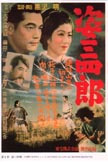 |
Judo Saga (1943)
This, the very first masterpiece created
by the legendary film director Akira Kurosawa at age 33, was
driven by his determination to create masterful moving pictures
on the screen. Kurosawa's ingenuity can be seen in the final
scene, a life or death struggle with gennosuke Higaki at Ukyougahara.
These intense scenes of the two character's jujitsu techniques
are boldly depicted by the innovative camera techniques used
by Kurosawa.
|
 |
The Most Beautiful (1944)
A documentary-style film staged in the
defeatist atmosphere of 1944, the film depicts the lives of
a devoted corps of female employees who were drafted to work
in a munitions factory. The film set was an operating optics
factory. There are no existing posters or fliers of this film's
release during World War II. An advertisment printed in the
March 19, 944 edition of the Asahi Graph was used for this
collection.
|
| |
|
|
|
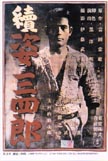 |
Judo Saga II (1945)
This is a sequel to Kurosawa's first film,
the very successful Judo Saga. In it, Tesshin and Genzaburo,
the two brothers of Gennosuke Higaki, challenge Sanshiro to
a duel to extract vengeance on behalf of their brother who
suffered defeat in the earlier film. The final duel was performed
by the actors barefoot at Shigakogen under severe winter conditions.
Susuma Fujita, playing the role of Sanshiro, gives an outstanding
performance in this film.
|
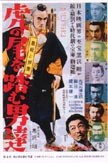 |
They Who Step on the Tiger's Tail (1945)
This distinctive film, based on the traditional
kabuki pla. Kanjincho, is Kurosawa's fourth film and
was created to have the atmosphere of a musical. The fim transforms
the episode of Yoshitune Minamoto trying to pass through a
checkpoint. Kenichi Enomoto, who plays Gouriki, a character
not in the original work, acheives a splendid performance.
This film, produced in 1945, was finally screened in 1952,
seven years afterwards because the subject of loyalty emphasized
in this film was seen as advocating the feudalistic ideas
of prewar Japan.
|
| |
|
|
|
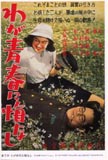 |
No Regrets for Our Youth (1946)
The first film Kurosawa made after the
war, the script is based on an actual incident of political
suppression, which occurred at Kyoto Imperial University in
the early Showa period and has a woman in the lead role. During
the post-war age when freedom and democracy were still considered
novel, the strong will which Setsuko Hara portrayed on the
screen gained sympathy from the young generation of the time.
|
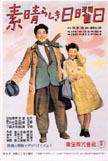 |
One Wonderful Sunday (1947)
Keinusoke Uegasa, a close friend of Kurosawa
from his elementary school days, wrote the script for this
film based on a day spent by an optimistic young couple in
the bleak postwar period. The film shows the attempts made
by the couple to fulfill their dreams. Movingly portrayed,
this film warmed the hearts of many audiences. An experimental
scene, where the audience is requested to applaud, became
the focus of considerable attention.
|
| |
|
|
|
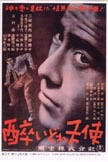 |
Drunken Angel (1948)
Toshiro Mifune, who makes his first appearance
in a Kurosawa film, is given a supporting role for the intriguing
facial expressions shown in his first movie appearance in
Ginrei No Hate (directed by Senkichi Taniguchi in 1947).
As the filming progressed, Mifune, with his swift reactions
and fine sensibilities, allowed Kurosawa to surpass his original
concept for the film. Kurosawa later described Mifune as an
ideal actor to work with. Both director and actor, later to
gain world-wide attention, encounter their destinies through
this film.
|
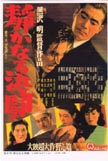 |
The Quiet Duel (1949)
A dedicated doctor working at a field
hospital contracts syphilis from a patient during surgery.
Forced by this condition to live chaste, he breaks his engagement
with his fiance. The agony and inner conflict the young doctor
encounters is depicted on screen with Kurosawa's descriptive
originality. The film was named Tsumi Naki Batsu while
the script was being written.
|
| |
|
|
|
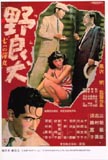 |
Stray Dog (1949)
The film begins with a young detective
from the Tokyo Police Department having his fully loaded gun
stolen while on a bus. Victims are soon found, slain with
bullets from his gun. The detective, in desparate pursuit,
becomes the one to be subconsciously cornered. Two men, both
de-mobilized soldiers, are driven to lead contrasting lives
in this film, which brutally reflects the times of postwar
Japan.
|
|
|
|
|
|
|
